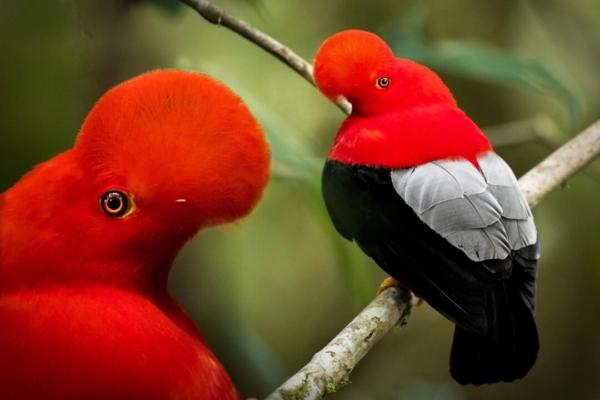In a mountainous wildlife sanctuary, travel photographers held up their long lenses, searching in the steamy, misty forests of Ecuador for a bright orange bird engaged in a spectacular courtship display.
Early in the morning, 48-year-old Claudia Brasileiro rushed from her hometown Brasilia, Brazil. Working at a bank during the day, she now traveled to Refugio Paz de Las Aves in the Andes Mountains to capture the breeding season of the Andean cock-of-the-rock.
Brasileiro and her guide Xavier Muñoz chose a specific spot within the sanctuary, located three hours northeast of San Domingo in the foothills, where the male birds perform their lekking courtship displays. After mating, they engage in a series of intricate display behaviors: wing-flapping displays of aggression, bowing to other males, and noisy calls.
But this particular morning was too quiet.
“A bird appeared, very far away, in poor lighting, and disappeared very quickly,” Brasileiro told The Epoch Times. “I was frustrated because I really needed good photos and timing to observe the behavior of these magnificent birds, but the outcome was not ideal.”
They both knew what they were looking for; the Andean cock-of-the-rock is highly conspicuous, almost impossible to miss. Most of its body is covered in deep orange or bright red feathers—creating a striking contrast in the green jungle—and its most distinctive feature is the large circular crest on its forehead. The tail feathers of this larger-sized passerine bird are black, and the shoulder feathers are grayish-white.
In the misty cloud forests of Ecuador, the sky is almost always covered in clouds. Due to the convenient location of Refugio Paz de Las Aves, many forest birds can be easily seen. The Andean cock-of-the-rock resides in tropical jungles near the equator of the Andes Mountains, unaffected by habitat destruction.
This location is ideal for nesting for the birds. During the breeding season, male birds show off their colorful plumage, vying for female attention—nodding up and down, jumping, making various calls. After mating, the female usually builds a nest under rocky outcroppings with mud and incubates the eggs alone. The female’s feathers are duller, brown in color, and the crest is not as prominent.
While this colorful bird primarily feeds on fruits and insects, it has also been observed preying on frogs, small reptiles, and even mice. However, after mating, the male does not hunt to feed the female, but gathers back at the lekking site to continue courtship displays to attract new partners, as the Andean cock-of-the-rock practices polygyny. Brasileiro and her companions arrived just in time for the breeding season. The timing was perfect. But the birds were nowhere to be seen.
At least not yet.
Though the start of the day was a bit dull, birdwatchers persisted in their search for the Andean cock-of-the-rock. The lekking season meant that many male birds would actively display, so there was a good chance of a performance. Brasileiro was visibly disappointed at not seeing them in the morning.
“Javier saw me crying,” Brasileiro said. He told her that sometimes the birds return in the evening, so they decided to come back then. And their luck indeed changed.
“We stood for over an hour, nothing happened. We were ready to give up, but we didn’t in the end,” Brasileiro said.
“Then I heard a bird calling in the distance and perching,” she added, “but I was very lucky, more than three birds started calling, dancing, and perching closer. Javier and I were both ecstatic, and I cried again… cried in gratitude for the gift of these birds.”
Brasileiro described it as an “amazing experience,” hearing their loud calls and watching their performance. She said they were not shy at all, constantly changing perches and coming very close to the photographers.
However, that wasn’t the only bird that appeared.
In her travels around the world—from India to Machu Picchu—Brasileiro always asks guides about tanagers, toucans, macaws, hummingbirds, and more, satisfying her endless passion for birdwatching and bird photography. This time was no different. She captured exotic species like the Andean toucanet, the blue-winged mountain tanager, and the golden-collared tanager. And many more.
“I have collected photos of 222 species of hummingbirds,” she said, out of a total of 363 species, “my goal is to reach two-thirds of the species by 2026—before my 50th birthday.” But she still has 20 more to go, admitting that “getting more than 10 on a single trip is increasingly difficult.”
Brasileiro has photographed thousands of bird species and published several books featuring bird photos. She calls herself a “crazy” birder, willing to go to great lengths to get her “lifers” (the first time seeing a bird species).
She recalled a trip: “six hours on a train, twelve hours by car, then two hours on a mule,” just to photograph the Himalayan monal.
“I’ve also done crazy things, like buying a ticket to Quito because a… super special hummingbird appeared,” she said, adding that she only had a few coins left in her pocket at the time, but eventually succeeded in taking photos.
“It was a great trip, I stayed in the hummingbird area for three days, had a few opportunities to photograph it,” she said. “On the last day, it was more cooperative, then disappeared again.”

